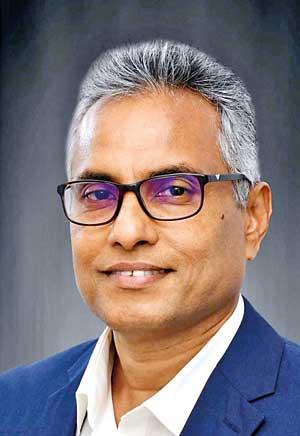10 Oct 2023 - {{hitsCtrl.values.hits}}
- The South Asian Grid should be connected with the ASEAN Grid
- The Indian grid’s installed capacity is over 400,000MW
- Electrical Energy demand is growing like nothing
- Sri Lanka being a country having a very large renewable energy potential will have enormous opportunities
Chartered Professional Engineer Dammika Nanayakkara in an interview with the Daily Mirror emphasised the importance of grid connectivity with India. He was the chairman of the Institution of Engineering and Technology (Sri Lanka Chapter 2015/16 and 2016/17). He is a fellow of the Institution of Engineers, Sri Lanka, and the Institution of Engineering and Technology, UK and a senior member of the Institute of Electrical and Electronics Engineers, USA.
the importance of grid connectivity with India. He was the chairman of the Institution of Engineering and Technology (Sri Lanka Chapter 2015/16 and 2016/17). He is a fellow of the Institution of Engineers, Sri Lanka, and the Institution of Engineering and Technology, UK and a senior member of the Institute of Electrical and Electronics Engineers, USA.
Excerpts:
 Q As an Engineer, what is your perspective on the proposed interconnection of the
Q As an Engineer, what is your perspective on the proposed interconnection of the national grids of Sri Lanka and India?
national grids of Sri Lanka and India?
It should be done. Regional grids have been in operation for decades and there are lots of benefits. If you consider the European electricity grid, all the national grids are connected to form the European grid; there are several inter-connections among European countries. The UK is connected to the European grid at three locations. See ASEAN countries; electricity grids of Singapore, Malaysia, Vietnam, Cambodia, Laos are connected together. Likewise, we need to develop the South Asian Electricity Grid. It is already happening. Already, Indian Grid, Bangladesh, Nepal grid and Butan grid are interconnected; Nepal is exporting electricity to both India and Bangladesh; Butan is exporting electricity to India and Bangladesh. Sri Lanka should also be part of this regional grid. Next, the South Asian Grid should be connected with the ASEAN Grid. This will enable power trading among many countries in the South Asian and ASEAN region where Sri Lanka can also be a power trader.
Q Technically, how feasible is it?
Technically it is feasible. Given the sensitivity of the marine environment in the region between Mannar and Rameshwaran and considering very shallow water depths in and around, an overhead transmission line will be more technically and economically feasible than an under-water cable connection.
Q What is the total wind and renewable energy capacity of Sri Lanka?
Renewable energy potential is enormous. Economically tangible on shore wind capacity is over 25 GW and offshore potential is over 50GW. Solar power potential is extremely large. If we install Solar PV panels on all household roof tops, 30GW capacity with 42,000 GWh of electricity can be produced. Just 1.5 times the area of Senanayake Samudraya is sufficient to generate annual electrical energy demand of the country from Solar PV plants alone. Sri Lanka has a large number of reservoirs, installing solar PV in 12% of the area of them can produce the country’s entire electrical energy demand of 16,000GWhs. Easily tangible, solar power potential is over 100GW. Along with renewable power development, storage facilities like battery storage for short-term variations, grid interconnection to Indian Grid and other means of storage like pump hydro, green hydrogen generation etc should be developed in parallel.
Q Some people fear grid connectivity will compromise the energy security of the country. What are your views on this?
It is the other way around. We are at the moment electricity self-sufficient; Sri Lanka has ambitious plans to develop the renewable sector; connecting our grid to the regional grid will enable us to export our excess renewable power to the region, not limited to India. On the other hand, we can import when there is scarcity. Also, interconnection will be very useful in maintaining grid stability. The Indian grid’s installed capacity is over 400,000MW. Sri Lanka is just 4000MW; one hundredth only. Let’s say, at a given time, Sri Lanka grid has 400MW excess power (that is 0.1% of Indian capacity), Indian Grid can easily absorb without any issue; Sri Lanka can agree on a pricing formula with Indian Grid operator for absorbing excess power in a manner beneficial for both parties and also to import when there is a necessity on real time basis within agreed technical limits; Sri Lanka can have stability benefit at a financial benefit to India.
Q What is the future of energy demand given India’s rise as an economic powerhouse?
Electrical Energy demand is growing like nothing. Not only India, but entire South Asia is still developing. By the time South Asia (India, Sri Lanka, Bangladesh, Bhutan etc) become higher middle income nations there should be at least 1,600,000 MW (i.e 1,600 GW) of electricity capacity installed in these countries. Also, green hydrogen (and ammonia) will become a fuel for electricity generation, transport and other industrial needs. Almost 100% of this energy demand will be supplied through renewable energy sources. Sri Lanka being a country having a very large renewable energy potential will have enormous opportunities in exporting green electricity as well as green energy in other forms. We must look at the big picture.
08 Jan 2025 38 minute ago
08 Jan 2025 44 minute ago
08 Jan 2025 1 hours ago
08 Jan 2025 5 hours ago
07 Jan 2025 07 Jan 2025